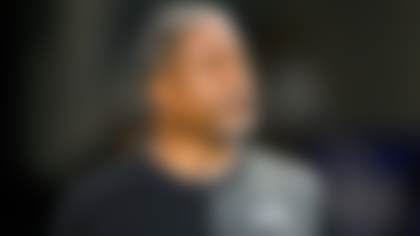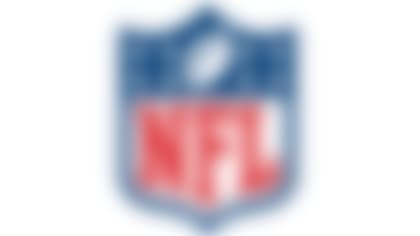INDIANAPOLIS -- Sunday marked the middle of a combine week of drills and evaluations for draft-eligible players.
The wide receivers tore up the 40-yard dash, but top prospects were rocked by an injury, a disappearing act and -- in the case of the quarterbacks -- some questions. The television coverage of the combine has some teams re-thinking whether they should watch it in person or stay home. And a number of players jumped out at me as NFL-ready.
Here's a look at what's going on, the ripple effect of some issues and a peak ahead at the combine's final few days.
1. Man, these guys are fast
The wide receivers lit up the 40-yard dash Sunday, hammering home the point that there are some full-fledged burners in this draft. Receivers with 4.3-second 40 times also might have inspired another group of players who could hit the 4.3 mark and must be considered deep threats in their own right.
The cornerbacks I spoke with took it as a challenge to match the wide receivers' numbers, and I expect players such as Connecticut's Darius Butler, Ohio State's Malcolm Jenkins, Illinois' Vontae Davis and Vanderbilt's D.J. Moore to demonstrate that they have the speed to cover the likes of Florida's Percy Harvin, Maryland's Darrius Heyward-Bey and Missouri's Jeremy Maclin. Keep your eye on the cornerbacks' 40 times Tuesday.
2. Top prospects have issues
Every stage of the player-evaluation process stirs up the pot again. Season-ending bowl games shift perceptions of players, the Senior Bowl provides another look at them and the combine throws in another twist. This year is no exception.
Texas Tech wide receiver Michael Crabtree might still be a top pick, but his foot injury could change teams' plans early in April's draft. One general manager told me it will make no difference in his evaluation of Crabtree, but another GM said he wouldn't risk a top-three pick on a wide receiver with a foot injury.
Then there was the questionable departure of Alabama offensive tackle Andre Smith. One GM said "this latest decision by Andre just reaffirms his immaturity and why I wouldn't take him in the top 10 spots."
Georgia's Matthew Stafford and USC's Mark Sanchez, the top two quarterback prospects, both measured less than 6-foot-3 and ran the 40 in the 4.8-second range. Right now, the projected top of the NFL draft is more in flux than it was a month ago.
3. Working from home
I ran into two head coaches who said they might consider not coming to the combine next season. Nothing against the whole process, but excellent TV coverage by the NFL Network allows most player observations to be done from home.
As for the personal interviews, these coaches said the typical canned answers given by overly prepared players offer very little insight. With free agency just days away, some of the coaches believed their time would be better served at home.
4. My favorite interviews
As usual, many players I had a chance to talk with really impressed me this week. I might add that between the Senior Bowl and my daily radio show on Sirius, I already have interviewed close to 100 draft-eligible players.
Sunday's first interview was with Larry English, a defensive end from Northern Illinois. English is a focused young man who oozes toughness and an intensity that will make any coach want him on his team.
Andre Brown, a running back from North Carolina State, jumps out at me as a guy who has it all. He's big (224 pounds), catches the ball well and runs fast. He told me with his quiet confidence that he would deliver a sub-4.5 40 -- and he did.
Alex Fletcher, a center from Stanford, isn't on every team's radar screen, but his 30 repetitions on the bench press and his good effort in the running events was only outshined by how he handled himself in interviews.
Darius Butler, a cornerback from Connecticut, has a confidence and an ability to talk about technique and scheme that made me feel like he has the FBI (football intelligence) to make it in the NFL.
5. Concerns at QB
Quarterback is starting to emerge as a position of concern. The top three prospects -- Stafford, Sanchez and Josh Freeman -- are all underclassmen, which was a yellow flag before the combine started. Then the top two prospects, Stafford and Sanchez, were measured under 6-3, and another yellow flag went up.
There is growing sentiment among teams that it might be time to rethink taking a quarterback in the first round and instead look to a later round for a guy who can develop. The quarterbacks who might be mid-round picks, based on how they looked Sunday, include Michigan State's Brian Hoyer, Purdue's Curtis Painter and Ball State's Nate Davis.
6. What to do with White?
West Virginia's Pat White is a fine athlete who worked out at the combine as a quarterback and was relaxed in doing so. White is such a talent that teams are discussing what to do with him and when he should be drafted. He could be a No. 3 quarterback with a chance to be a No. 2, but he also can run the Wildcat, play slot receiver and return punts and kicks.
As one GM said, "I want him on my team, and now I just have to figure out where I have to take him."
7. No longer flying under the radar
A few players who weren't household names emerged. Ohio State wide receiver Brian Robiskie had a great day. USC wide receiver Patrick Turner didn't run the 40, but he looked good catching the ball, especially in the gauntlet drill.
Nevada wide receiver Marko Mitchell, who measured close to 6-4 and 218 pounds with 10¼-inch hands, caught a number of balls behind his back and grabbed the attention of a few coaches. Kory Sheets broke 4.4 seconds in the 40, and he played in a Purdue offense that prepares running backs for the pro game. Sheets jumped out at scouts during his drill work.



